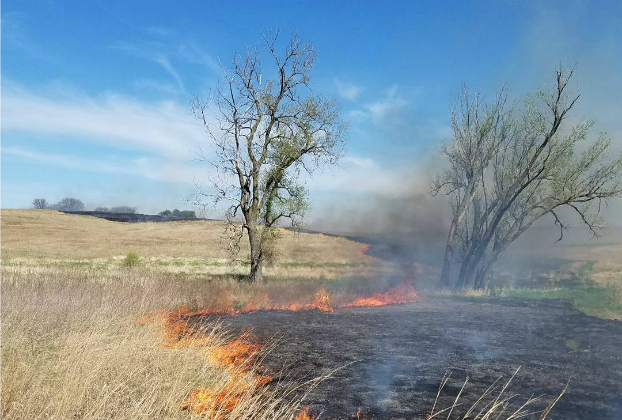Preserve Management - Tallgrass Prairie Restoration (the Allwine Prairie Tract)

Prescribed Burning
Glacier Creek Preserve conducts prescribed burns to replicate the historic role of fire in maintaining a vigorous tallgrass prairie. The first prescribed burn was conducted in the spring of 1970 with the restoration burned in its entirety and variously mowed until 1974. Starting in 1975, the 140 acre original restoration was divided into three management units with only one unit burned each spring. This rotation maintained the 3-year fire return interval which is estimated to approximate historic fire frequency. Over the years, this fire frequency has been shown to maintain, across the Preserve, a diversity of habitats for species favoring various stages of post-burn plant community characteristics. In 2016, two of the three burn units were further subdivided to facilitate smaller burned areas, although the 3-year fire return interval standard remains across the preserve.
Visit our Prescribed Burning page to learn more about prescribed burning and how you can get involved.
Mowing and Other Management
The entire restoration was mulch-mowed at various times from 1970 through 1977 in order to reduce ruderal (aka “weedy”) plants and facilitate the establishment of seeded prairie species. Between 1978 and 2009, portions of the preserve were hayed in some years, mostly in the lowland, but never with any regularity. Today, mulch-mowing only occurs as part of the treatment of long-term research plots. In addition to prescribed burning and mowing, present land management practices include mechanical and chemical control of noxious and invasive species and woody plants. Management activities include efforts to increase plant diversity by collecting seeds from local native prairie remnants and scattering them at pre-determined locations across the preserve. Records are retained on where and when seeds were collected and scattered.
To learn how to get involved with these land management projects, visit the Volunteer page.
Preserve Management - Recent Acquisitions (the Papio Tract, Barbi Hayes Overlook, and Bouteloua Tract)
Most of the recently acquired land is leased and used for rotation between corn and soybean crops while we move toward its restoration to prairie and prairie-associated habitats. These areas are leased for cultivation on a year-by-year basis, although small areas have been set aside for specific research projects. Keeping the land in cultivation eliminates the need to control large areas of ruderal species while also supplementing our operating budget as we gear up with equipment and supplies to manage more than two times the amount of land than was in the original preserve.
Starting in 2021, the Papio Tract was developed into a stream and wetland mitigation bank by the Papio-Missouri River Natural Resources District. In this restoration, in addition to reconstructing the Glacier Creek stream channel, swales were created across the site to allow for standing water during the spring which will provide habitat for amphibian reproduction. A similar effort was conducted along the North Creek lowland. In time, the uplands on both the Barbi Hayes Overlook and the Bouteloua Tract are to be restored to the tall or mixed-grass prairie with strategically placed areas of oak savanna. In the Bouteloua Tract, the historic wetland will be managed to reduce further head cutting so that it can continue to function as one of several active headwater sources of Glacier Creek.